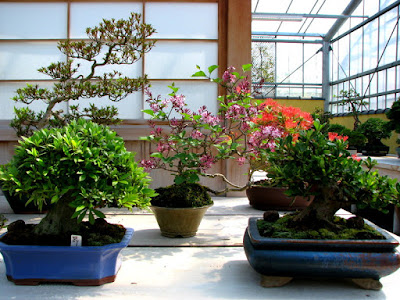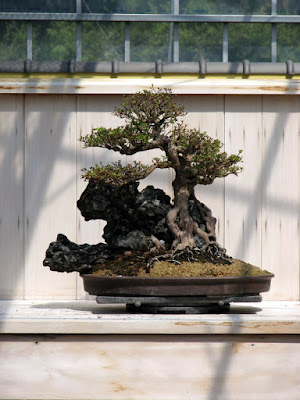Craziness coupled with some weariness has kept me from my appointed entries, and I have been reprimanded by a faithful reader. So here you are ME, another day of photographs from Japan. However, I must warn you that these pictures are from the afternoon after visiting the mountainous bonsai garden of the master Hasaka. That's not the problem; these pictures were taken at the Tosho-gu Shrine in Nikko. If my readers are like my fellow travelers, some of you are probably tired of shrines. It's only to be expected; their interests lay primarily in bonsai, and they were getting eager for the big show which wouldn't open for another three days.
I can't remember where I saw this building with the terrific window, but I think it must have been near the ticket area for the Shrine. Wherever it was taken, it's now a painting waiting to happen
If you decide to skim through the following, I won't be offended (actually, I won't even know unless you email me). For many of the photos that follow, I will merely give a brief blurb. But here I will introduce that this shrine is all about. First, some of the information comes from our tour guide, but a good deal of the specific functions of the buildings comes from the Eyewitness Travel Guide: Japan (quotations are from that book). This shrine is the mausoleum of one of the earliest shoguns and was erected by his grandson. Like any old wooden structure many of the buildings have be rebuilt and some more than once. It is currently being restored, but as you will see, a lot of that work has already been finished.
This wonderful pagoda dated from 1650, but was rebuilt in the early 19th century. What I have just learned (from the Eyewitness Travel Japan book) is that, "Each story represents an element - earth, water, fire, wind, and heaven in ascending order."
I do love the guardian spirit, and this one looks disapprovingly at the laughing ticket taker!
A bonsai tree that we saw earlier in our trip is being brought in for the display of top bonsai specimens. This is no easy task!
Roof lines. Need I say more?
This building is used as an occasional stable for the horse New Zealand donated to the site, however, it's the decoration you'll get the biggest kick out of. I am showing you only one close-up of the monkeys that are doing something different in each of the 5 sections.
This is a sacred fountain for washing hands "with an ornate Chinese-style roof."
A library of Buddhist scriptures is behind one bonsai, and there is a second bonsai below (not the huge one you viewed in an earlier photo).
I admit I have dozens of photos the next structure, the Yomeimon Gate. Every single surface, inside and out, ceilings, walls, roof, and exterior, is heavily and beautifully decorated.
Tucked in among the roof "layers" is :
A man playing an instrument:
Men playing a board game and many more which I didn't include.
The painting on the ceiling inside the of the Gate.
Oops, more men - these two are riding a dragon (on the left) and a fish (on the right).
Incredible decorations from top to bottom.
When you pass through and turn around to look back at the Gate, you can see that restoration is still being done on it. On this side, one of the columns is deliberately upside down - to avoid offending or tempting the gods to wreak havoc on something too perfect. Sound familiar?
Behind one building is quite an amazing wall.

.
Here is a sleeping cat above a doorway.
Sometimes, saki (that's what is in the round containers) is given as a donation to the Shrine instead of money. Looks like they might have enough.
A beautiful golden peony . . .
And where I found it:
To give you a sense of the size of the cedars all around the shrine, I asked David to stand in front of the trunk of this one. The cedar avenue that leads to the shrine was planted in the 17th century as a donation to the shrine.
And I'll leave you with a rather scary elephant:





























































